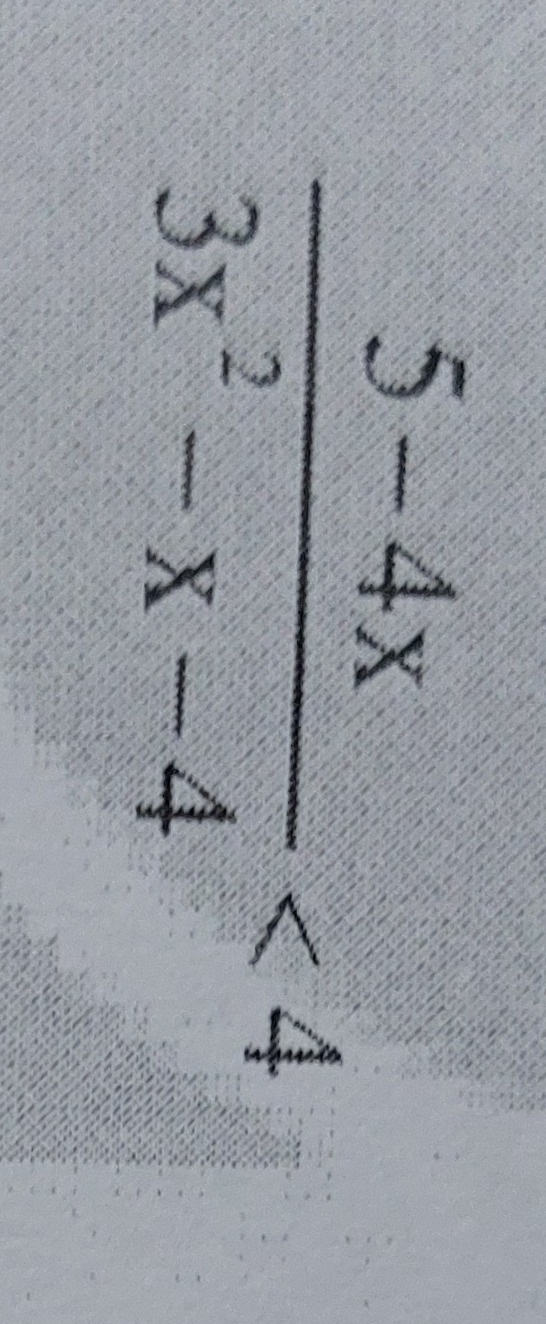Question
Question: $\frac{3x^2}{5-4x} < 4$ $-x-4$...
5−4x3x2<4 −x−4

(3−8−231,3−8+231)∪(45,∞)
Solution
The given inequality is 5−4x3x2<4. To solve this, we move all terms to one side:
5−4x3x2−4<0
Combine the terms on the left side into a single fraction:
5−4x3x2−4(5−4x)<0
5−4x3x2−20+16x<0
5−4x3x2+16x−20<0
Now, we find the roots of the numerator and the denominator. For the numerator, 3x2+16x−20=0. Using the quadratic formula x=2a−b±b2−4ac:
x=2(3)−16±162−4(3)(−20)
x=6−16±256+240
x=6−16±496
x=6−16±16×31
x=6−16±431
x=3−8±231
Let the roots of the numerator be r1=3−8−231 and r2=3−8+231.
For the denominator, 5−4x=0.
4x=5
x=45
Let the root of the denominator be r3=45.
We need to order these critical points on the number line. 31 is between 5 and 6, approximately 5.57.
r1=3−8−231≈3−8−2(5.57)=3−8−11.14=3−19.14≈−6.38
r2=3−8+231≈3−8+2(5.57)=3−8+11.14=33.14≈1.05
r3=45=1.25
The ordered critical points are r1<r2<r3.
The inequality is 5−4x3x2+16x−20<0. Let f(x)=−(4x−5)3(x−r1)(x−r2)=−4(x−r3)3(x−r1)(x−r2). This can be written as f(x)=−43(x−r3)(x−r1)(x−r2). We want f(x)<0, which means −43(x−r3)(x−r1)(x−r2)<0. Multiplying by −34 (which is negative) reverses the inequality sign:
(x−r3)(x−r1)(x−r2)>0.
We use the wavy curve method or test intervals for the expression (x−r3)(x−r1)(x−r2). The critical points are r1,r2,r3. The critical points divide the number line into four intervals: (−∞,r1), (r1,r2), (r2,r3), and (r3,∞).
Let g(x)=(x−r3)(x−r1)(x−r2).
-
For x>r3: (x−r1)>0, (x−r2)>0, (x−r3)>0. So g(x)=(+)(+)(+)>0.
-
For r2<x<r3: (x−r1)>0, (x−r2)>0, (x−r3)<0. So g(x)=(−)(+)(+)<0.
-
For r1<x<r2: (x−r1)>0, (x−r2)<0, (x−r3)<0. So g(x)=(−)(+)(−)>0.
-
For x<r1: (x−r1)<0, (x−r2)<0, (x−r3)<0. So g(x)=(−)(−)(−)<0.
We are looking for the intervals where g(x)>0. These are (r1,r2) and (r3,∞). Substituting the values of r1, r2, and r3:
The solution is x∈(3−8−231,3−8+231)∪(45,∞).
